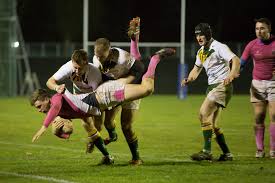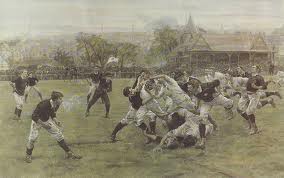Main Menu
Latest Blog Entry
User login
Strength and Power Developments in Rugby over the last 10 years.
 Strength and Power in Rugby
Strength and Power in Rugby
Now that we have reached the knock out stages of the Rugby World Cup, I thought it would be a good time to review how the game has changed over the last 10 years.
Simon Worsnop is the National Adviser with the England Under 20s team and has kindly written the following post.
Both codes of rugby are defined as collision sports i.e. players purposely collide with each other. Other collision sports are American Football, Australian Rules Football, Ice Hockey and Gaelic Football. These sports are very different in their laws and therefore technical and physical demands.
Rugby League and Rugby Union: the collision
Rugby Union and Rugby League sit in between the extremes of Australian and American Football. Both sports require speed, agility, a high level of strength and power and also a moderate to high level of cardiovascular fitness.
The two codes of rugby have common and different forms of collision. Both codes of rugby involve the ball carrier being stopped and sometimes put to ground by one or more opponents. In rugby league the tackled player retains the ball, in rugby union there can be a contest for the ball in either a ruck where the tackled player has gone to ground or a maul where the tackled player is on his feet.
The different components of fitness have a bearing on the outcome of the collision/tackle area. A team that dominates the tackle area will normally win the game. The ball carrier needs to use good footwork (agility) to try to avoid a collision or to find the edge of an opponent and enter the collision on his own terms. The ball carrier needs power to break through the initial impact and acceleration to get away if he breaks the defender.
When the tackle is made the defending and attacking players need strength to dominate the collision to finish it on their terms. For the defender this will involve leg strength to lift and drive his opponent and also upper body strength in order to twist and turn the ball carrier.
To get a picture of the intense nature of the collision in modern rugby just watch “rugby big hits” The characteristics of the collision have fundamentally altered rugby since the onset of professionalism.
To subjectively observe this buy a game DVD from the 1960s or 70s of either code and compare it to today’s games.
The collision has altered for a number of reasons; the players are bigger (particularly the backs), the laws of both games have changed e.g. in rugby league the 10m rule means the players are running a minimum of 10m before they collide. The players have got stronger and this generally translates into greater acceleration and therefore greater relative speed at the impact.
 Now, before old timers from both codes shout me down I am not saying that yesterday’s players were anything but skilful, aggressive and tough and I am not arguing that the games are better now than then.
Now, before old timers from both codes shout me down I am not saying that yesterday’s players were anything but skilful, aggressive and tough and I am not arguing that the games are better now than then.
What I am saying is that the games that are played now are different and that is primarily due to full time professionalism and with it years of strength training.
Can you repeat this power and strength throughout a match?
The ability to express muscular power under game specific fatigue appears critical to preventing fatigue-induced decrements in tackling technique.
Fatigue will result in progressive reductions in tackle technique; there being a significant association between estimated endurance (VO2 Max) and agility and fatigue-induced decrements in tackle technique (1)
Therefore fitness levels have implications for the injury of players as the majority of rugby league injuries occurred in the tackle (2)
The tackle area as a site of injury was also found to be the case in International Rugby Union where “the incidence of match injuries at international level was found to be higher than previously reported. The tackle, ruck, and maul elements of match play presented the highest risk of injury for all players”. (3)
Thus, there are specific minimum standards of cardiovascular endurance that players at any level of rugby should have as a defence against tackle-induced injury.
Part 2 of this piece will appear tomorrow.
See our Get Stronger programme here
References
1: (Influence of Fatigue on Tackling Technique in Rugby League Players Tim Gabbett Journal of Strength & Conditioning Research 22(2) 2008).
2: (Rugby League Injuries and Playing Position Tim Gabbett Journal of Strength & Conditioning Research 19(4) 2005).
3: (J H M Brooks, C W Fuller, S P T Kemp and D B Reddin A prospective study of injuries and training amongst the England 2003 Rugby World Cup squad Br. J. Sports Med. 2005;39;288-293).
Client Testimonials
 Middlesex LTA
Middlesex LTA
James has been training the top performance players in the county and has proved a great success. The sessions are well organised and the feedback and the programmes given to the players are excellent.
More


Comments
[…] be suggested that the use of Olympic lifts in the athletes programme will be a useful addition to rugby forwards. However, research needs to further its examination into the effect of Olympic lifting on other […]
[…] a tight head prop has to overcome massive external resistance in both the scrum and in the contact areas. It makes […]
[…] ACCELERATION is the correct and simplest word for quickness and agility, and this is the highest priority in many sports, except where the athlete has to move large external masses. […]
[…] fitness training for young rugby players is more important than just putting on weight. Strength and power developments in rugby Guest post looking at the demands of the International matches and how players need to prepare […]